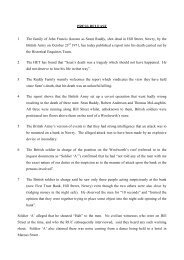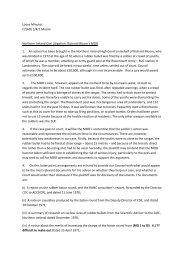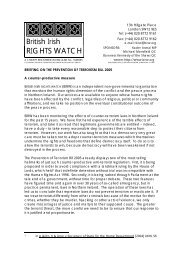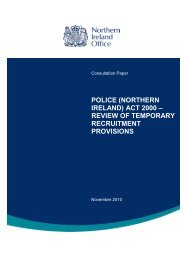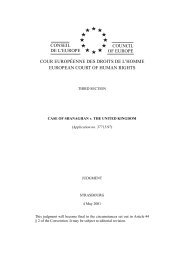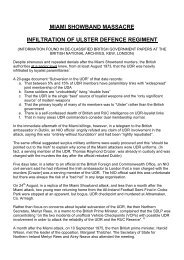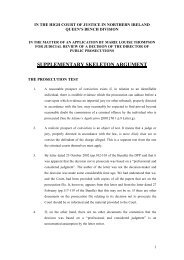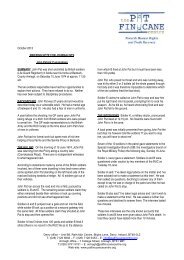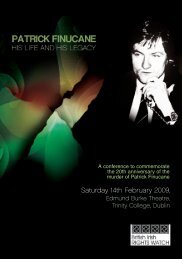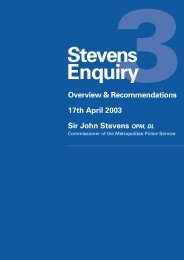McGurk's Bar Bombing - The Pat Finucane Centre
McGurk's Bar Bombing - The Pat Finucane Centre
McGurk's Bar Bombing - The Pat Finucane Centre
You also want an ePaper? Increase the reach of your titles
YUMPU automatically turns print PDFs into web optimized ePapers that Google loves.
14 July 2008 : Column 116<br />
was, until the terrible bombing in Omagh in August 1998, the largest civilian loss of life in a<br />
single incident during the years of the troubles.<br />
We are discussing tonight one of 363 reports produced so far by Northern Ireland’s Historical<br />
Enquiries Team. Established in 2005, the HET is part of the Police Service of Northern<br />
Ireland, but it is operationally independent and staffed by a mix of people, including former<br />
detectives from outside Northern Ireland. Just last week, in its latest report, the Northern<br />
Ireland Affairs Committee expressed themselves<br />
“impressed by the personal commitment, sensitivity and professionalism of the Chief<br />
Constable, the Director of HET and the other staff involved in HET”.<br />
<strong>The</strong> HET is tasked with reviewing all 3,268 deaths that occurred as a result of the troubles<br />
between 1968 and 1998, with the twofold aim of striving to bring a measure of resolution to<br />
families and ensuring that all investigative and evidential opportunities are subject to<br />
thorough and exhaustive examination. Its approach is family centred and in its review of the<br />
McGurk’s bar bombing, the HET has attempted to answer more than 50 questions from<br />
family members. To carry out this work effectively, the HET has developed a five-phase<br />
process that includes the collection, assessment and review of all relevant and available<br />
material followed by focused reinvestigation and resolution. In this review as in others, the<br />
HET accessed witness statements, forensic reports, the original police case papers and<br />
intelligence information.<br />
Every one of the deaths that occurred during the troubles is a tragedy, but each case is also<br />
unique and families will have different views and perspectives and different questions and<br />
issues of concern. Following the McGurk’s bar bombing, the hurt and grief felt by all those<br />
directly affected and, indeed, by the wider community was intensified by the inaccurate<br />
commentary and reporting that it was the result of a so-called IRA “own goal”.<br />
In summary, the HET reached the following conclusions. <strong>The</strong> bomb was located inside<br />
McGurk’s bar within a small, enclosed entrance area off Great George’s street, but outside the<br />
public bar area where the victims and survivors were mainly located. <strong>The</strong> original target, as<br />
my hon. Friend mentioned, was probably the Gem bar rather than McGurk’s.<br />
<strong>The</strong> Ulster Volunteer Force was responsible for the bombing and in 1978 Robert James<br />
Campbell pleaded guilty to 15 counts of murder and was given a life sentence. <strong>The</strong> HET<br />
found no evidence of collusion by the police or security services with the UVF and confirmed<br />
that the Royal Ulster Constabulary allocated substantial resources to the original investigation<br />
in 1971. Its assessment, however, was that those carrying out the investigation may have<br />
attributed more significance to the potential involvement of republican paramilitaries than the<br />
balance of evidence supported.<br />
<strong>The</strong> HET's report also documents in some detail the media reports of the bombing. It includes<br />
the transcript of an interview with an eight-year-old boy, Joseph McClory, who gave a very<br />
clear account of how he saw a man place the bomb in the porch of the pub. Even so, there was<br />
speculation that one or more of those inside the pub might have been responsible. As my hon.<br />
Friend said, the HET report includes a copy of a Ministry of Defence document stating—this<br />
is a direct quotation from the document—



